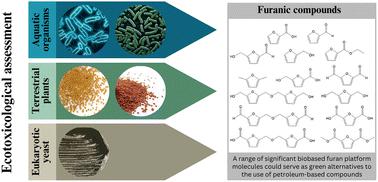当前位置:
X-MOL 学术
›
Environ. Sci.: Processes Impacts
›
论文详情
Our official English website, www.x-mol.net, welcomes your feedback! (Note: you will need to create a separate account there.)
Ecotoxicological assessment of biomass-derived furan platform chemicals using aquatic and terrestrial bioassays
Environmental Science: Processes & Impacts ( IF 5.5 ) Pub Date : 2024-02-12 , DOI: 10.1039/d3em00552f Stella Parmaki 1 , Marlen I. Vasquez 1, 2 , Maria Patsalou 1 , Rafael F. A. Gomes 3 , Svilen P. Simeonov 3, 4 , Carlos A. M. Afonso 3 , Michalis Koutinas 1
Environmental Science: Processes & Impacts ( IF 5.5 ) Pub Date : 2024-02-12 , DOI: 10.1039/d3em00552f Stella Parmaki 1 , Marlen I. Vasquez 1, 2 , Maria Patsalou 1 , Rafael F. A. Gomes 3 , Svilen P. Simeonov 3, 4 , Carlos A. M. Afonso 3 , Michalis Koutinas 1
Affiliation

|
An environmental toxicological assessment of fourteen furanic compounds serving as valuable building blocks produced from biomass was performed. The molecules selected included well studied compounds serving as control examples to compare the toxicity exerted against a variety of highly novel furans which have been additionally targeted as potential or current alternatives to biofuels, building blocks and polymer monomers. The impact of the furan platform chemicals targeted on widely applied ecotoxicity model organisms was determined employing the marine bioluminescent bacterium Aliivibrio fischeri and the freshwater green microalgae Raphidocelis subcapitata, while their ecotoxicity effects on plants were assessed using dicotyledonous plants Sinapis alba and Lepidium sativum. Regarding the specific endpoints evaluated, the furans tested were slightly toxic or practically nontoxic for A. fischeri following 5 and 15 min of exposure. Moreover, most of the building blocks did not affect the growth of L. sativum and S. alba at 150 mg L−1 for 72 h of exposure. Specifically, 9 and 11 out of the 14 furan platform chemicals tested were non-effective or stimulant for L. sativum and S. alba respectively. Given that furans comprise common inhibitors in biorefinery fermentations, the growth inhibition of the specific building blocks was studied using the industrial workhorse yeast Saccharomyces cerevisiae, demonstrating insignificant inhibition on eukaryotic cell growth following 6, 12 and 16 h of exposure at a concentration of 500 mg L−1. The study provides baseline information to unravel the ecotoxic effects and to confirm the green aspects of a range of versatile biobased platform molecules.
中文翻译:

使用水生和陆地生物测定法对生物质衍生的呋喃平台化学品进行生态毒理学评估
对十四种呋喃化合物进行了环境毒理学评估,这些呋喃化合物是由生物质产生的有价值的构件。所选分子包括经过充分研究的化合物,作为对照示例,以比较对各种高度新颖的呋喃的毒性,这些呋喃还被瞄准作为生物燃料、结构单元和聚合物单体的潜在或当前替代品。利用海洋生物发光细菌Aliivibrio fischeri和淡水绿色微藻Raphidocelis subcapitata确定了针对广泛应用的生态毒性模型生物的呋喃平台化学品的影响,同时利用双子叶植物Sinapis alba和Lepidium sativum评估了它们对植物的生态毒性影响。关于评估的具体终点,在暴露 5 分钟和 15 分钟后,所测试的呋喃对费氏放线菌具有轻微毒性或几乎无毒。此外,在 150 mg L -1暴露 72 小时的情况下,大多数结构单元不会影响L. sativum和S. alba的生长。具体而言,测试的 14 种呋喃平台化学品中,有 9 种和 11 种分别对L. sativum和S. alba无效或有刺激作用。鉴于呋喃是生物精炼发酵中常见的抑制剂,使用工业主力酵母酿酒酵母研究了特定结构单元的生长抑制,结果表明,在 500 mg 浓度下暴露 6、12 和 16 小时后,对真核细胞生长的抑制作用微不足道L -1。该研究提供了基线信息,以揭示生态毒性效应并确认一系列多功能生物基平台分子的绿色方面。
更新日期:2024-02-12
中文翻译:

使用水生和陆地生物测定法对生物质衍生的呋喃平台化学品进行生态毒理学评估
对十四种呋喃化合物进行了环境毒理学评估,这些呋喃化合物是由生物质产生的有价值的构件。所选分子包括经过充分研究的化合物,作为对照示例,以比较对各种高度新颖的呋喃的毒性,这些呋喃还被瞄准作为生物燃料、结构单元和聚合物单体的潜在或当前替代品。利用海洋生物发光细菌Aliivibrio fischeri和淡水绿色微藻Raphidocelis subcapitata确定了针对广泛应用的生态毒性模型生物的呋喃平台化学品的影响,同时利用双子叶植物Sinapis alba和Lepidium sativum评估了它们对植物的生态毒性影响。关于评估的具体终点,在暴露 5 分钟和 15 分钟后,所测试的呋喃对费氏放线菌具有轻微毒性或几乎无毒。此外,在 150 mg L -1暴露 72 小时的情况下,大多数结构单元不会影响L. sativum和S. alba的生长。具体而言,测试的 14 种呋喃平台化学品中,有 9 种和 11 种分别对L. sativum和S. alba无效或有刺激作用。鉴于呋喃是生物精炼发酵中常见的抑制剂,使用工业主力酵母酿酒酵母研究了特定结构单元的生长抑制,结果表明,在 500 mg 浓度下暴露 6、12 和 16 小时后,对真核细胞生长的抑制作用微不足道L -1。该研究提供了基线信息,以揭示生态毒性效应并确认一系列多功能生物基平台分子的绿色方面。



























 京公网安备 11010802027423号
京公网安备 11010802027423号